Morning Eye Candy: Cirrus
Posted in Around the Garden on September 21 2012, by Matt Newman
To see the Summer Sky
Is Poetry, though never in a Book it lie —
True Poems flee —
Emily Dickinson
Photo by Ivo M. Vermeulen

Inside The New York Botanical Garden
Posted in Around the Garden on September 21 2012, by Matt Newman
To see the Summer Sky
Is Poetry, though never in a Book it lie —
True Poems flee —
Emily Dickinson
Photo by Ivo M. Vermeulen
Posted in Emily Dickinson, Exhibitions on July 7 2010, by Plant Talk
 |
Jane Dorfman is Reference Librarian/Exhibitions Coordinator in the LuEsther T. Mertz Library. |
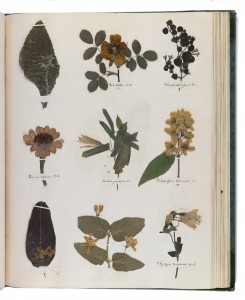 How did Emily Dickinson prepare her herbarium? That is the topic addressed in the current window display of the LuEsther T. Mertz Library’s Rare Book and Folio Room.
How did Emily Dickinson prepare her herbarium? That is the topic addressed in the current window display of the LuEsther T. Mertz Library’s Rare Book and Folio Room.
At 14 years of age, Dickinson, inspired by her readings and botanical studies at Amherst Academy, gathered, dried, pressed, mounted, and identified over 400 plants for her herbarium. She was enthusiastic about the project. She asked her friend Abiah Root in a letter if she had made a herbarium yet and encouraged her to pursue such a project. Dickinson even enclosed a geranium leaf for her friend to press.
In the Library’s William D. Rondina and Giovanni Foroni LoFaro Gallery exhibition of Dickinson’s life, which runs through August 1, a digitized version of the poet’s herbarium is on display. Made available through Turn the Pages Technology, visitors can view Dickinson’s original herbarium virtually by “turning” the pages on a touchscreen. A printed version of Dickinson’s herbarium is included in the Rare Book and Folio Room display.
This small exhibit shows how 19th-century botany enthusiasts created herbaria. The collecting tin (known as a vasculum) belonging to the celebrated botanist John Torrey is on display as well as a botany text by noted instructor Mrs. Almira Lincoln Phelps, a text that Dickinson used in her studies.
Also on view are the materials used in creating a herbarium today, including glue, twine, mounting paper, blotting paper, and a herbarium press. In addition, dried specimens of Monotropa uniflora (Indian pipe) and Heliotropium arborescens L. (heliotrope), two of Dickinson’s favorite plants, are presented, courtesy of the Garden’s William and Lynda Steere Herbarium..
The Rare Book and Folio Room display can be viewed during Library hours through Labor Day.
Posted in Emily Dickinson, Exhibitions on June 11 2010, by Plant Talk
Joyce Carol Oates Takes Center Stage at Poetry Series Saturday
This is the final weekend to experience first hand the life and works of one of America’s most treasured poets in Emily Dickinson’s Garden: The Poetry of Flowers.
And remember, the Gallery exhibition in the LuEsther T. Mertz Library, which gives an interactive perspective of Dickinson’s life through photographs, watercolors, manuscripts, her virtual herbarium, and her white dress fis on through August 1. |
Posted in Exhibitions on June 3 2010, by Plant Talk
Gallery Exhibition Delves into Poet’s Love of Nature
 |
Judith Farr is Professor Emerita of English and American Literature at Georgetown University and author of The Passion of Emily Dickinson and The Gardens of Emily Dickinson. |
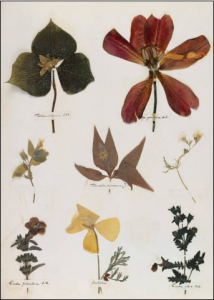 It is not widely known that our great American poet Emily Dickinson (1830–1886) was a practiced gardener before she became an accomplished poet. She joined her gentle mother tending the classic contents of a cottage garden—roses, cyclamen, lobelia, tulips, and more—at only 12 years of age while her training under the famous New England educator Edward Hitchcock taught her the elements of botany in childhood.
It is not widely known that our great American poet Emily Dickinson (1830–1886) was a practiced gardener before she became an accomplished poet. She joined her gentle mother tending the classic contents of a cottage garden—roses, cyclamen, lobelia, tulips, and more—at only 12 years of age while her training under the famous New England educator Edward Hitchcock taught her the elements of botany in childhood.
Indeed, nearly half of Dickinson’s lyrical letters to family and chosen friends and over one-third of her brilliantly idiosyncratic poems appeal to nature for the images and themes that render them incisive and unforgettable. Only a few of Emily Dickinson’s poems were printed during her lifetime but many people remembered receiving one of them, often tucked into an exquisite bouquet that she had grown and arranged herself.
Therefore, it is fitting that The New York Botanical Garden presents Emily Dickinson in her reciprocal roles as Poet and Gardener in its exhibition Emily Dickinson’s Garden: The Poetry of Flowers. While an array of the flowers about which she wrote blooms outdoors at the Garden, the LuEsther T. Mertz Library Gallery showcases materials designed to introduce visitors to the life and art of Emily Dickinson. The Gallery Exhibition, which will run to August 1, is built around several significant themes in Dickinson’s life, such as her childhood, her gardening, and her poetry.
Posted in Emily Dickinson, Exhibitions on May 28 2010, by Plant Talk
 |
Noelle V. Dor is Museum Education Intern in the Everett Children’s Adventure Garden. |
The delicate unfurling of fresh leaves…
The kaleidoscopic flowering of plants small and large…
The courtship dances of birds and bees…
The cycling of sunshine and rain to nourish new life…
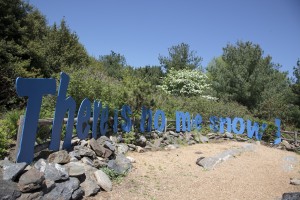 There is hardly a more poetic season than spring. All of nature is waking up and bursting forth in variously colored, scented, textured, and melodic ways. It’s no wonder that we, too, are moved to find refreshment for our own lives. When immersed in a space of natural beauty and vitality, some of us are even motivated to translate those experiences into artistic expressions. Inspired by well-versed poet and gardener Emily Dickinson, the Everett Children’s Adventure Garden has seamlessly blended nature and art to spark this dynamically creative process among visitors to the exhibition Emily Dickinson’s Garden: The Poetry of Flowers.
There is hardly a more poetic season than spring. All of nature is waking up and bursting forth in variously colored, scented, textured, and melodic ways. It’s no wonder that we, too, are moved to find refreshment for our own lives. When immersed in a space of natural beauty and vitality, some of us are even motivated to translate those experiences into artistic expressions. Inspired by well-versed poet and gardener Emily Dickinson, the Everett Children’s Adventure Garden has seamlessly blended nature and art to spark this dynamically creative process among visitors to the exhibition Emily Dickinson’s Garden: The Poetry of Flowers.
Posted in Emily Dickinson, Exhibitions on May 19 2010, by Plant Talk
 |
Jessica Blohm is Interpretive Specialist for Public Education. |
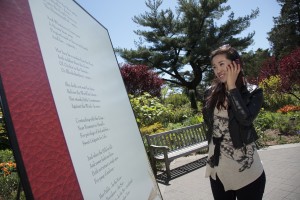 The exhibition Emily Dickinson’s Garden: The Poetry of Flowers features a Poetry Walk, a self-guided tour highlighting 35 of Dickinson’s poems on signs located among the Botanical Garden’s collections, near the plants and flowers that inspired her.
The exhibition Emily Dickinson’s Garden: The Poetry of Flowers features a Poetry Walk, a self-guided tour highlighting 35 of Dickinson’s poems on signs located among the Botanical Garden’s collections, near the plants and flowers that inspired her.
Visitors stroll along Perennial Garden Way—during the peak of spring flowering season—observing Dickinson’s muses such as daffodils, roses, daisies, tulips, and conifers.
An audio commentary, accessible by cell phone, illuminates her life and her love of nature, flowers, and gardens. Providing insight into her poetry are Dickinson experts Judith Farr, Professor Emerita of English and American Literature at Georgetown University and author of The Gardens of Emily Dickinson; Marta McDowell, historic garden specialist, instructor at The New York Botanical Garden, and author of Emily Dickinson’s Gardens: A Celebration of a Poet and Gardener; and Alice Quinn, Executive Director of the Poetry Society of America.
To access the audio tour, look for the audio tour symbol on signs on the Garden grounds. Call 718.362.9561, enter the prompt number noted on the sign followed by the # key.
For instance, enter 515# to hear an explanation of the Dickinson poem below. And enjoy!
I hide Myself within my flower,
That fading from your Vase,
You, unsuspecting, feel for me –
Almost a loneliness.
From The Poems of Emily Dickinson, ed. R.W. Franklin (Cambridge, Mass.: The Belknap Press of Harvard Univ. Press, 1998). F 80b
Posted in Emily Dickinson, Exhibitions on May 14 2010, by Plant Talk
Author Finds Striking Comparison with Garden’s Re-Creation
 |
Marta McDowell is author of Emily Dickinson’s Gardens: A Celebration of a Poet and Gardener and teaches landscape history at The New York Botanical Garden, where she studied landscape design. |
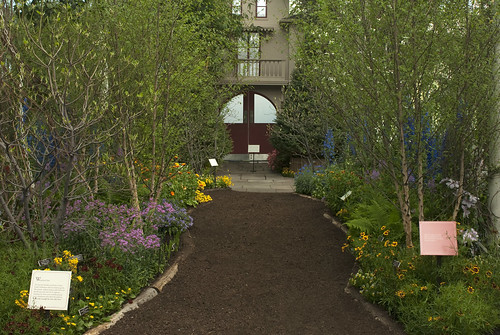 The other day I drove from the Botanical Garden to Amherst, Massachusetts, bookending a visit to Emily Dickinson’s Garden: The Poetry of Flowers with a call on Emily Dickinson’s home, the Homestead, at the Emily Dickinson Museum. Winding through Westchester County and western Connecticut, I turned onto Interstate 91 following the Connecticut River up the so-called Pioneer Valley, settled by Dickinson’s ancestors in search of good agricultural land. The unseasonably warm spring weather we were having trailed me north from the Bronx, with the temperature reading in the mid-80s on the car thermometer when I finally got to Emily’s B&B (where else?) on North Prospect Street.
The other day I drove from the Botanical Garden to Amherst, Massachusetts, bookending a visit to Emily Dickinson’s Garden: The Poetry of Flowers with a call on Emily Dickinson’s home, the Homestead, at the Emily Dickinson Museum. Winding through Westchester County and western Connecticut, I turned onto Interstate 91 following the Connecticut River up the so-called Pioneer Valley, settled by Dickinson’s ancestors in search of good agricultural land. The unseasonably warm spring weather we were having trailed me north from the Bronx, with the temperature reading in the mid-80s on the car thermometer when I finally got to Emily’s B&B (where else?) on North Prospect Street.
Posted in Emily Dickinson, Exhibitions, Programs and Events on May 7 2010, by Plant Talk
 |
Gayle Schmidt is Manager of Public Education. |
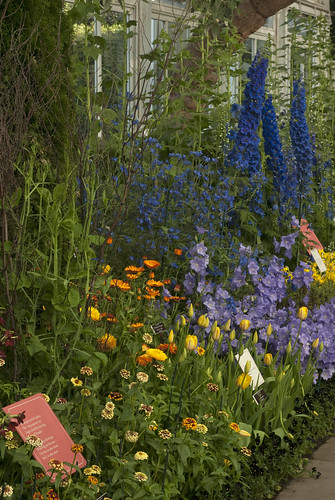 It’s not a surprise that the Garden is always busy on Mother’s Day—good children associate beautiful things like flowers with their nurturing mothers. The day gives us an opportunity to share out loud our appreciation for our moms for everything they do and have done each day of our lives.
It’s not a surprise that the Garden is always busy on Mother’s Day—good children associate beautiful things like flowers with their nurturing mothers. The day gives us an opportunity to share out loud our appreciation for our moms for everything they do and have done each day of our lives.
One of the activities the Garden has planned for the weekend during Emily Dickinson’s Garden: The Poetry of Flowers will help you explore more of the Garden and will allow you to create a card for Mom that says something special—in words and in flowers!
In Emily Dickinson’s day, a popular pastime was to make a tussie-mussie based on the period’s language of flowers— each flower representing a different meaning. Many books were sold as guides so that one could learn, for instance, what a secret admirer bearing flowers thought.
Posted in Emily Dickinson, Exhibitions, Programs and Events on April 30 2010, by Plant Talk
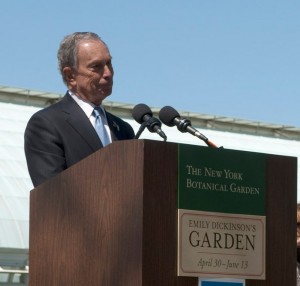 Mayor Bloomberg, Sigourney Weaver, State Poet Kick Off Exhibition Mayor Bloomberg, Sigourney Weaver, State Poet Kick Off Exhibition
During her lifetime, Emily Dickinson The show features a re-creation of Dickinson’s home and garden in the Haupt Conservatory, an exposition about her life in the Mertz Library, and a Poetry Walk, a self-guided tour, with Dickinson’s poems on signs located among the Botanical Garden’s collections, near the flowers that inspired her.
The Big Read Marathon Poetry Reading and other kickoff events for Emily Dickinson’s Garden continue all weekend.
Don’t miss out. The forecast looks great for the next few days, and the Poetry Walk in the Garden is the perfect way to spend a sunny day. |
Posted in Emily Dickinson, Holiday Train Show on January 6 2010, by Plant Talk
Celebrating the Season and Looking Ahead to Our Spring Exhibition
 Carol Capobianco is Editorial Content Manager at The New York Botanical Garden.
Carol Capobianco is Editorial Content Manager at The New York Botanical Garden.
Garden staff members have been busy learning all they can about Emily Dickinson and her poetry in advance of the Botanical Garden’s spring exhibition, Emily Dickinson’s Garden: The Poetry of Flowers, May 1–June 13, 2010. We take note wherever and whenever we see her name.
So when we saw in a datebook, by chance, a gingerbread recipe by Emily Dickinson, we decided to blog about it, since the Garden currently is presenting Gingerbread Adventures in the Everett Children’s Adventure Garden as part of the Holiday Train Show.
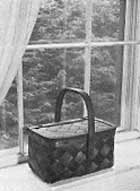 With a little digging around I learned that Dickinson had a bit of a reputation as a baker in her hometown of Amherst, Massachusetts. In fact, she was particularly known for her gingerbread (and Rye and Indian bread), and would lower a basket of it to children below (photo by Lewis S. Mudge, courtesy of his estate), according to Emily Dickinson: Profile of the Poet as Cook, with Selected Recipes, by Nancy Harris Brose, Juliana McGovern Dupre, Wendy Tocher Kohler, and Jean McClure Mudge, and published in 1976. We have a copy of this 28-page booklet in the LuEsther T. Mertz Library, where in spring 60 objects that tell the story of Dickinson’s life will be on view in the Rondina and LoFaro Gallery. (Complementing this will be a re-creation of her garden in the Enid A. Haupt Conservatory and a poetry walk throughout the Garden’s grounds.)
With a little digging around I learned that Dickinson had a bit of a reputation as a baker in her hometown of Amherst, Massachusetts. In fact, she was particularly known for her gingerbread (and Rye and Indian bread), and would lower a basket of it to children below (photo by Lewis S. Mudge, courtesy of his estate), according to Emily Dickinson: Profile of the Poet as Cook, with Selected Recipes, by Nancy Harris Brose, Juliana McGovern Dupre, Wendy Tocher Kohler, and Jean McClure Mudge, and published in 1976. We have a copy of this 28-page booklet in the LuEsther T. Mertz Library, where in spring 60 objects that tell the story of Dickinson’s life will be on view in the Rondina and LoFaro Gallery. (Complementing this will be a re-creation of her garden in the Enid A. Haupt Conservatory and a poetry walk throughout the Garden’s grounds.)
My intention was simply to post the recipe here, with permission from Jean Mudge, and let you try it out for yourself. However, I got caught up in the “everything Emily” mood, and to celebrate her 179th birthday (December 10), I decided to try making the recipe myself to share with co-workers.